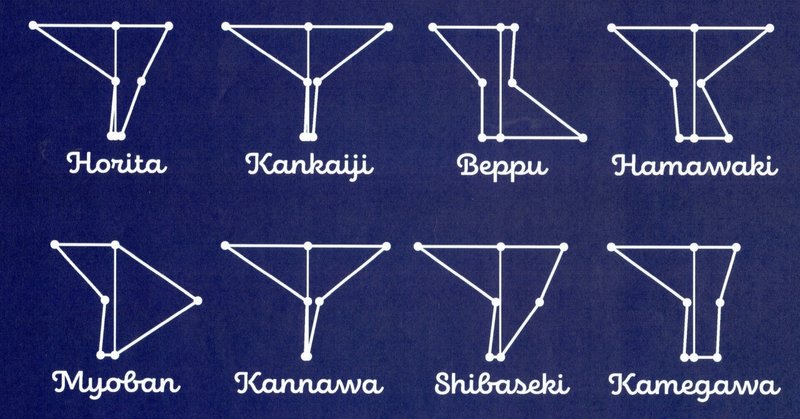
Kannawa Walk Guide
[Basic itinerary] (120 minutes)
(1) Meet at Otani Park
(2) Jigoku—mushi Kobo (Geothermal Steam Cooking Center)
(3) Onsenzan Eifukuji Temple
(4) Mushi-yu (geothermal steam bath, the original form of bath)
(5) Fujiya (a former “ryokan”, or a traditional Japanese accommodation, with a history of over a century)
(6) Netsu-No-Yu (a “jimo-sen” or a communal public bathhouse)
(7) The Kannawa Fault
(8) Geothermal steam cooking experience "Geothermal Tourism Lab Enma"
(9) Yumetake (a device to cool off hot spring water to good-to-bathe temperature without adding water)
(10) Dismissed at Otani Park
1) Otani Park
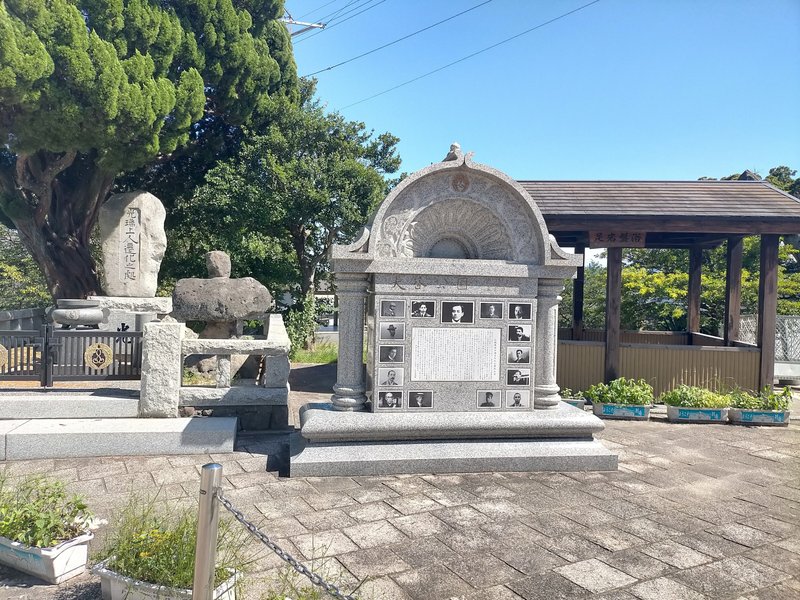
Otani Park was constructed in memory of Otani Kozui, the former head of the largest Buddhist sect in Japan called Jodo-shinshu and the leader of Otani Expedition which was sent to Central Asia for the purpose of exploring the route of the spread of Buddhist to the East. The expedition took place three times between 1902 and 1910. The headquarters of this sect is located in Kyoto. Why is this park located in Beppu? Because Otani Kozui fell seriously ill and came to Beppu to receive medical treatment at Beppu National Hospital. He lived in a house which stood at the present park site until he passed away in 1948 at the age of 71.
※ Dry Foot Bath
In the park, there is an interesting “foot bath” under an arbor-like building. Its floor is laid with rocks, under which runs hot spring steam, so you can warm your feet. This facility is for park visitors and free of charge.
2) Jigokumushi Kobo Kannawa (Geothermal Steam Cooking Center)

As you go down the slope behind Otani Park, a facility called Jigokumushi-kobo is located. That is a Beppu-city-run cooking center where visitors can experience cooking using hot spring steam ovens. Hot spring steam has traditionally been used for cooking in the Kannawa area for hundreds of years. Below this cooking center, there is a foot bath, which is free of charge.
The Kannawa Onsen area of Beppu City has long flourished as a hot spring resort.
Jigokumushi Kobo Kannawa is a facility where visitors can experience geothermal steam cooking, which is called Jogokumushi (hell steaming), a traditional cooking method. This method has been used in Kannawa since the Edo period.
In the past, jigokumushi cooking was done only by those guests staying at those spa retreat inns, and there were not many facilities where tourists in general could experience jigokumushi cooking.
At the pocket park next to Jigokumushi Kobo Kannawa is a hot spring footbath, which is wheelchair-accessible, can be experienced free of charge.
Foot bathing
Foot baths and foot steaming are collectively referred to as such.
In foot bathing, blood heated in the feet circulates throughout the body, gradually having effects on circulation, respiration, nerves, and immune function similar to those achieved by full body bathing. It is said that when a healthy person places both their legs at 42°C for 20 minutes, 2 degrees Celsius in their lower legs temperature, and 0.5 degrees Celsius in their core body will rise. Heart rate also increases, while blood pressure decreases. The effect lasts for 20 minutes after getting out of the foot baths. The recommended temperature for a foot bathing is 42-44°C for 15 minutes on the average. After foot bathing, be sure to wipe off the water and keep the legs warm.
Avoid foot bathing when under the following conditions:
・ Foot bathing immediately after exercise or after consuming alcohol
・ When you have a fever (37.5°C or higher)
・ Severe cases of arteriosclerotic occlusive disease of the lower extremities
・ Acute phase of thrombophlebitis
・ When experiencing sensory disturbance due to diabetic neuropathy or brain stroke
3) Onsenzan Eifukuji Temple (founded by Ippen Shonin (Saint Ippen), who had calmed the “hell” (thermal fumarole field) of Kannawa)
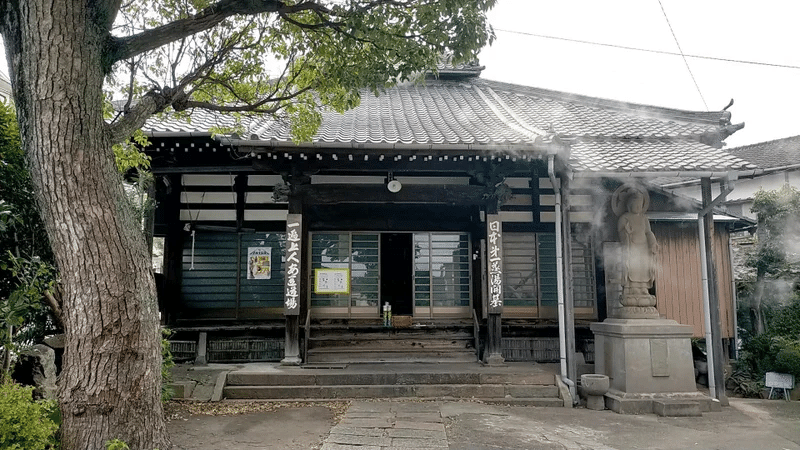
Eifukuji Temple, which is associated with Ippen Shonin, or Saint Ippen. The temple has an honorific prefix "Onsenzan" (or mountain of hot spring) and is located in the Furomoto (or base of bath) area. There is also an "Onsen Shrine" nearby, which was once a precinct shrine of Eifukuji Temple until it was moved to its current location following the Ordinance of Distinguishing Shinto and Buddhism during the Meiji period in late 1800’s. These facts suggest that this temple is at the heart of Kannawa Onsen.
Ippen Shonin was born in the 13th century near Dogo Onsen in Ehime Prefecture on Shikoku Island, and he later became the founder of the "Jishu" sect of Buddhism which is characterized by chanting sutras while dancing. During his journey of training and propagation, he reached Kannawa upon landing from the sea at "Shoninga-hama" beach. An old man passing by told him about the Kannawa Hell, where the steam from the hot springs was creating heavy mists that caused problems for the local people. Ippen Shonin then wrote a sutra character on each stone and threw the stones into the hot springs and calmed most of the hells. He then surrounded the four corners of the fumarole that remained steaming with these stones and created a steam bath. This was the beginning of the "Kannawa steam bath," and this is where the geographical name of the location, "Furomoto," comes from.
The third generation of Otomo clan who governed Oita Prefecture, Yoshimune Otomo, revered Ippen and his teachings, and built Eifukuji Temple of the Jishu sect of Buddhism. The temple's treasure is "Yugyo Shonin-den Emaki Dainana (Picture Scroll No. 7 of Saint’s Journey)", which is a Nationally Designated Important Cultural Property, is preserved at this temple and is open to the public every September during the "Yuami Festival", when a statue of Ippen Shonin is bathed in Shibu-no-yu Public Bath House and Mushiyu Steam Bath.
The top spring source of Shibu-no-Yu public bath managed by Beppu City, welling within the precincts of the temple contains 689.6 mg/L of metasilicic acid, which is said to be a natural moisturizer, and this amount is one of the highest concentration in Japan.
4) Mushiyu (or geothermal steam bath: the original form of bath)

The protruding ends of the building of Kannnawa Mushiyu facility are the steam baths—one for men and the other for women--each of which is a stone room about 8 tatami mats in size (about 3.6m x 3.6m). You enter through a wooden door about 1 square meter in size, and lie down on the floor covered with medicinal herb called Sekisho. Inside the stone room is dimly lit, and the ceiling is low, so first-time visitors may be a bit surprised. The room is filled with thermal steam, so as soon as you lie down, you will start sweating from all over your body. The attendant sets a timer for 8 minutes, and you will be called to get out when the time is up.
This steam bath is said to be good for neuralgia, muscle pain, joint pain, and recovery from fatigue. In addition, when the sekisho spread out on the floor is steamed at high temperatures, the herbal leaves release an aroma composed of terpenes that have a pain-relieving or soothing effect, which are absorbed into your body through the skin and respiratory organs, further enhancing the effects of steam bathing.
Sekisho grows in clusters along clear stream waters, and those used at Kannawa Mushiyu Beppu are gathered from different areas by the city employees working for the Onsen Department. The collected herbal leaves are dried and preserved for use.
Mushiyu has foot steam baths—free of charge--on its premises, and they are both managed by the city.
Kannawa Mushiyu’s current building was built in 2006, and it has a long history dating back to 1276, when it was first set up by Ippen Shonin. The history of how it was run is unknown. However, record shows that in the early Edo period (1603-1867) a considerable number of people used Mushiyu and money was collected for bathing. In 1925, Takeshi Hieda wrote "Beppu Onsen" (Beppu Hot Springs), which describes the structure and efficacy of the Mushiyu, and in it he says, "beside the entrance of the steam bath is a stack of crutches dedicated to Yakushi Nyorai (often referred to as the Healing Buddha) from the Mushiyu users as a token of appreciation for the complete recovery from incurable illnesses. The divine effects of Mushiyu is just astonishing.”
Just across the foot baths is where the Mushiyu was originally located. The monument there is made of stones that were used in the former Kannawa Mushiyu. The crutches depicted there represent the crutches that were dedicated from the healed in the past.
There is also a monument with a poem written by Ujo Noguchi, a writer of children’s songs, which reads, "A scent of Sekisho lingers on my skin on my way back from Mushiyu in Bungo Kannawa spa resort”.
There is also a statue of Ippen Shonin.
(5) Fujiya Ryokan (a former ryokan, or a Japanese inn, built over 100 years ago)
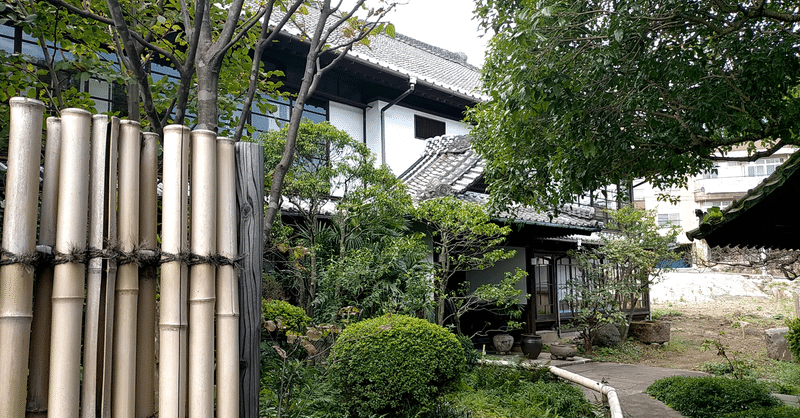
Built in 1897, it is a two-story wooden building with a key-shaped, pantile roof, and is the nly emaining ryokan structure from the Meiji era in Beppu. When the inn was still up and running, it was voted the most popular ryokan in Oita Prefecture on a polling done by a newspaper company. Back in those days, most of the inns in Kannawa were kashima (or a rent-a-room inn), and the hot spring retreat guests stayed in shared rooms. Fujiya Ryokan was the first inn to offer private rooms for one night with two meals. Ito Den'emon and Asou Taikichi, who were referred to as the "Coal Barons of Chikushi," were regular guests of the inn.
There is a 200-year-old Usugimokusei tree (or Osmanthus fragrans var. thunbergii) here, a special protected tree designated by Oita Prefecture, which produces fragrant pale yellow flowers in autumn.
The ryokan closed in 1996. The architecture was then registered as a National Tangible Cultural Property in 2001 and underwent restoration work from 2002 to 2004, reopening in April 2004 as Fujiya Gallery Hanaya-momo. The building includes a concert hall, gallery space, café, and gallery shop, and visitors can tour the building by using the café. The building is used not only as a café, but also as a venue for concerts, exhibitions, and other events as a Meiji-era building where visitors can sense the history and atmosphere of Kannawa Onsen.
*"Hanaya-momo" (or “start of 100”): Named with the determination to restart the 100-year old building to pass on for another century.
(6) Netsu-no-yu (or the heat spring) (“Jimosen”: a local community bathhouse)
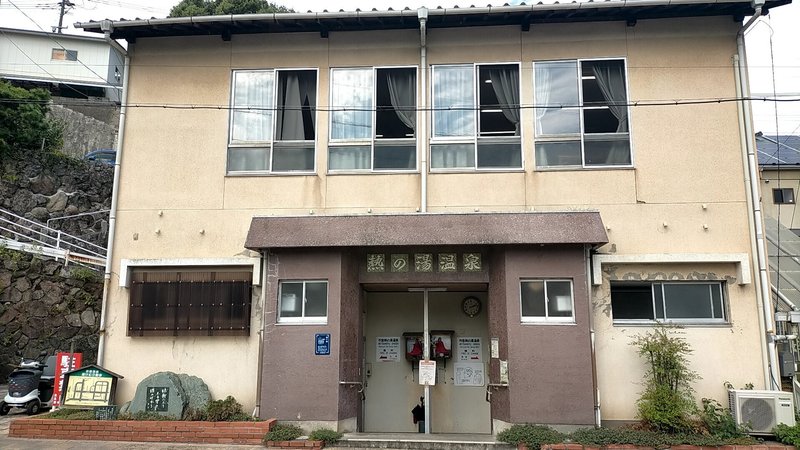
Netsu-no-yu is the only municipal hot spring in Kannawa Onsen area where anyone can bathe for free. On the second floor of the bathhouse is a community center, which is a common structure of communal bathhouses in Beppu.
With free parking space, the bathhouse is used by locals as well as tourists. One may imagine very hot water from its name “Netsu-no-yu” (literal translation "hot water of heat"). However, the name is interestingly said to have derived from its effectiveness in removing body heat.
There used to be a hot spring drinking fountain (the site still exists on the left side of the building), a cooking area, and a laundry area (still exists on the right side of the building. The hot spring also used to be called the fever-reducing spring).
The spring type of Netsu-no-yu is a sodium-chloride spring, which warms the body and long preserves the body heat.
Netsu-no-yu is also one of the hot spring facilities participating in the "Beppu Hatto Onsen Road" stamp rally (in which you collect stamps of 88 participating hot spring facilities in a designated “spaport” booklet and become a “Meijin” or “master of hot springs of the 8 spa resort areas in Beppu”. The stamp for Netsu-no-yu is placed at the neighboring ryokan Irifune-so.)
(7) Kannawa Fault (introduced in Bura Tamori)

The area where this stone wall is located is a naturally formed cliff, a fault scarf.
A fault is a relative displacement of the ground at a particular border (or a fracture between two blocks of rock). There are four types of faults: normal fault, reverse fault, right lateral fault, and left lateral fault).
(By the way, there is a border in the middle of this stone wall where you can see the difference in masonry. The tightly constructed part is said to have been built by the father of the current master (i.e. the former master) of the Irifune-so inn).
This fault is called the Kannawa Fault, which was previously featured on Bura Tamori, an educational travelogue variety program broadcasted on NHK (Japan’s national public broadcasting organization. It is one of the major faults created by volcanic activity that became active about 30,000 years ago (at around the end of the Ice Age, when mammoths were flourishing). The fault runs from the direction of Mt. Garandake, a volcano located behind Myoban Onsen, through the Kannawa area, down to the coast.
These faults are essential for Beppu's hot springs to well out. Three elements are necessary for a hot spring to yield, and they are water, a heat source, and a waterway. In the case of Beppu, the water source is rainwater, the heat source is magma deep underground, and the waterway is the fault.
Type of Fault Features
(1) (2) (3) (4)
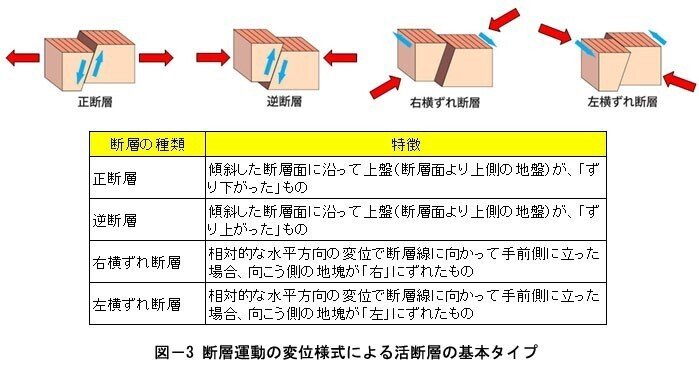
Type of Fault Features
(1)Normal Fault 【正断層】
A dip-slip fault in which the block above the fault has moved downward relative to the block below.
(2)Reverse (or Thrust) Fault 【逆断層】
A dip-slip fault in which the upper block, above the fault plane, moves up and over the lower block.
(3)Right-Lateral (Strike-Slip) Fault 【右横ずれ断層】
One on which the horizontal displacement of the far block is to the right when viewed from either side.
(4)Left-Lateral (Strike-Slip) Fault 【】左横ずれ断層】
One on which the horizontal displacement of the far block is to the left when viewed from either side.
Basic types of active faults according to displacement patterns of fault movement
8)Jigokumushi Cooking Experience at Enma
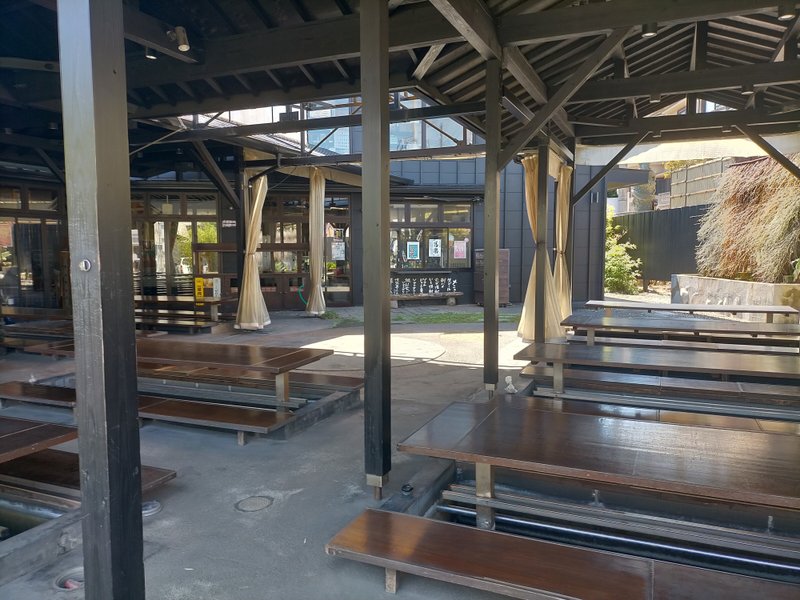
At the facility called “Geothermal Tourism Lab Enma”, you can cook food using their hot spring steam ovens. Bamboo weaving experience is also available at Enma.
Jigokumushi (Hell Steam) Cuisine
In the Kannawa area, hot spring steam has been used for cooking for hundreds of years. This cooking method is called Jigokumushi in Japanese, which literally means “hell-steaming”.
It is the wisdom of daily living utilizing the geothermal steam, a simple cooking method that utilizes the nearly 100 degrees Celsius “hell” steam to steam food. In the past, farmers used to bring their crops with them and stay at a “Toji” (spa retreat) inn for a hot springs retreat during their off-season. A variety of ingredients can be steamed, including vegetables, meat, and seafood. You can also stew food or cook rice by using pots and other cooking utensils.
Historically, people used geothermal steams to cook boiled (or steamed) eggs in various areas in Japan. However, cooking meals using fumaroles was possible in Beppu, which was blessed with an abundance of hot spring wells and mineral water that sprang out of them.
For Jigokumushi, they use steam ovens into which hot spring steam is conducted. You usually place a pan or a pot on a cooking stove, but you place a colander with food on in a steam oven.
Hot spring water in the Kannawa area contains much sodium-chloride or salt, so food which is cooked in a Jigokumushi oven has a slight salty taste. This simple cooking method brings out the full flavor of every food.
Kannawa was well-known as an onsen “toji” town for hundreds of years. “Toji” means staying at a spa for a certain period of time to take hot spring baths for therapeutic purposes. People brought in their food and cooked for themselves during their stay at so-called “rent-a-room” inns using Jigokumushi ovens.
9)Yumetake Hot Spring Water Cooler
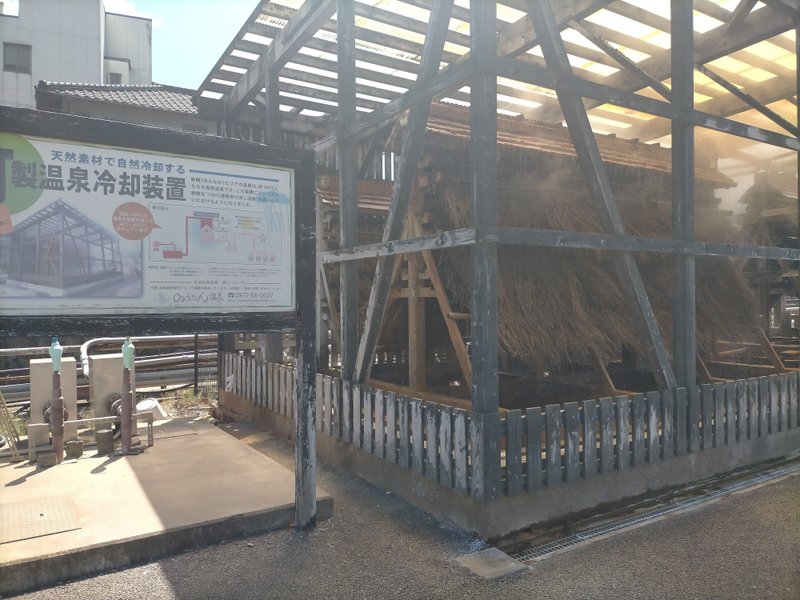
This device made of camphor wood and bamboo branches through which hot spring water runs is a water cooler and is named “Yumetake”(literally meaning “dream rain bamboo”). As boiling spring water releases heat by pouring down the bamboo branches, its temperature is instantly cooled to about 50 degrees Celsius.
This revolutionary Yumetake is owned by Hyotan Onsen, one of the most popular hot spring public bath houses in Beppu. This water cooler was set up in 2005 in Beppu, where the bamboos grow and is traditionally known for its bamboo arts and crafts.
Why is this device necessary? Because by cooling down boiling hot spring water instantly, the water’s effects are retained.
Hyotan Onsen has two hot spring wells and their water temperature is almost 100 degrees Celsius, and in order to use the water in their baths, it needs to be much lower than that. If they let the water stay for many hours or if they add cold water to cool down to a temperature appropriate for bathing, the water loses its hot spring effects.
Yumetake was devised by Hyotan Onsen in cooperation with Oita Industrial Research Institute.
4) Mushiyu (or geothermal steam bath: the original form of bath)
The protruding ends of the building of Kannnawa Mushiyu facility are the steam baths—one for men and the other for women--each of which is a stone room about 8 tatami mats in size (about 3.6m x 3.6m). You enter through a wooden door about 1 square meter in size, and lie down on the floor covered with medicinal herb called Sekisho. Inside the stone room is dimly lit, and the ceiling is low, so first-time visitors may be a bit surprised. The room is filled with thermal steam, so as soon as you lie down, you will start sweating from all over your body. The attendant sets a timer for 8 minutes, and you will be called to get out when the time is up.
This steam bath is said to be good for neuralgia, muscle pain, joint pain, and recovery from fatigue. In addition, when the sekisho spread out on the floor is steamed at high temperatures, the herbal leaves release an aroma composed of terpenes that have a pain-relieving or soothing effect, which are absorbed into your body through the skin and respiratory organs, further enhancing the effects of steam bathing.
Sekisho grows in clusters along clear stream waters, and those used at Kannawa Mushiyu Beppu are gathered from different areas by the city employees working for the Onsen Department. The collected herbal leaves are dried and preserved for use.
Mushiyu has foot steam baths—free of charge--on its premises, and they are both managed by the city.
Kannawa Mushiyu’s current building was built in 2006, and it has a long history dating back to 1276, when it was first set up by Ippen Shonin. The history of how it was run is unknown. However, record shows that in the early Edo period (1603-1867) a considerable number of people used Mushiyu and money was collected for bathing. In 1925, Takeshi Hieda wrote "Beppu Onsen" (Beppu Hot Springs), which describes the structure and efficacy of the Mushiyu, and in it he says, "beside the entrance of the steam bath is a stack of crutches dedicated to Yakushi Nyorai (often referred to as the Healing Buddha) from the Mushiyu users as a token of appreciation for the complete recovery from incurable illnesses. The divine effects of Mushiyu is just astonishing.”
Just across the foot baths is where the Mushiyu was originally located. The monument there is made of stones that were used in the former Kannawa Mushiyu. The crutches depicted there represent the crutches that were dedicated from the healed in the past.
There is also a monument with a poem written by Ujo Noguchi, a writer of children’s songs, which reads, "A scent of Sekisho lingers on my skin on my way back from Mushiyu in Bungo Kannawa spa resort”.
There is also a statue of Ippen Shonin.
この記事が気に入ったらサポートをしてみませんか?
